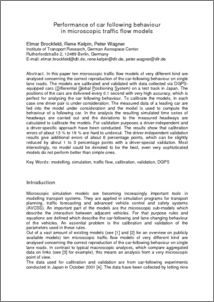|
|
Performance of car following behaviour in microscopic traffic flow models
Brockfeld, Elmar und Kelpin, Rene und Wagner, Peter
(2004)
Performance of car following behaviour in microscopic traffic flow models.
In: Networks for Mobility 2004, Proceedings - Abstracts and CD-ROM, Seite 43.
Universität Stuttgart.
2nd International Symposium "Networks for Mobility", 2004-09-29 - 2004-10-01, Stuttgart (Deutschland).
ISBN 3-89301-180-3.
![[img]](https://elib.dlr.de/style/images/fileicons/application_pdf.png)  Vorschau |
|
PDF
209kB |
KurzfassungMicroscopic simulation models are becoming increasingly important tools in modelling transport systems. They are applied in simulation programs for transport planning, traffic forecasting and advanced vehicle control and safety systems (AVCSS). An important part of the models are the microscopic sub-models which describe the interaction between adjacent vehicles. For that purpose rules and equations are defined describing the car-following and lane changing behaviour of the vehicles. An essential problem is the calibration and validation of the parameters used in these rules. In this paper ten microscopic traffic flow models of very different kind are analysed concerning the correct reproduction of the car-following behaviour on single lane roads. The models are calibrated and validated with data collected via DGPS-equipped cars (Differential Global Positioning System) on a test track in Japan. The positions of the cars are delivered every 0.1 second with very high accuracy, which is perfect for analysing the car following behaviour. To calibrate the models, in each case one driver pair is under consideration. The measured data of a leading car are fed into the model under consideration and the model is used to compute the behaviour of a following car. In the analysis the resulting simulated time series of headways are carried out and the deviations to the measured headways are calculated to calibrate the models. To find the optimal parameters an automated optimisation technique is used which tries to minimise the deviations. For validation purposes the resulting optimal parameter sets for single data sets are taken to reproduce some other data sets by simulation. At first, this is done in a driver independent way, where the drivers in the data set used for the calibration are different from those used for the validation. Secondly, to investigate whether individual driver behaviour can be reproduced better a driver-special validation is conducted, where the calibrated parameter sets obtained for each driver are taken to validate the behaviour of the same driver in other situations. Main results of the analyses are that all models produce nearly the same errors, thus sophisticated models with up to 15 parameters seem not to be better than simple models with only 4 or 6 parameters. In total it is found that the differences in the driver behaviour are much bigger than the diversity of the models. At last, the validation with special driver pairs produces slightly better results than the driver-independent validation. Thus, the behaviour of individual drivers can be reproduced a bit more accurately than trying to transfer optimal parameter results from one driver to another. | elib-URL des Eintrags: | https://elib.dlr.de/21349/ |
|---|
| Dokumentart: | Konferenzbeitrag (Vortrag, Paper) |
|---|
| Titel: | Performance of car following behaviour in microscopic traffic flow models |
|---|
| Autoren: | | Autoren | Institution oder E-Mail-Adresse | Autoren-ORCID-iD | ORCID Put Code |
|---|
| Brockfeld, Elmar | NICHT SPEZIFIZIERT | NICHT SPEZIFIZIERT | NICHT SPEZIFIZIERT | | Kelpin, Rene | NICHT SPEZIFIZIERT | NICHT SPEZIFIZIERT | NICHT SPEZIFIZIERT | | Wagner, Peter | NICHT SPEZIFIZIERT | NICHT SPEZIFIZIERT | NICHT SPEZIFIZIERT |
|
|---|
| Datum: | 2004 |
|---|
| Erschienen in: | Networks for Mobility 2004, Proceedings - Abstracts and CD-ROM |
|---|
| Referierte Publikation: | Ja |
|---|
| Open Access: | Ja |
|---|
| Gold Open Access: | Nein |
|---|
| In SCOPUS: | Nein |
|---|
| In ISI Web of Science: | Nein |
|---|
| Seitenbereich: | Seite 43 |
|---|
| Herausgeber: | | Herausgeber | Institution und/oder E-Mail-Adresse der Herausgeber | Herausgeber-ORCID-iD | ORCID Put Code |
|---|
| Möhlenbrink, W. | NICHT SPEZIFIZIERT | NICHT SPEZIFIZIERT | NICHT SPEZIFIZIERT | | Englmann, F.C. | NICHT SPEZIFIZIERT | NICHT SPEZIFIZIERT | NICHT SPEZIFIZIERT | | Friedrich, M. | NICHT SPEZIFIZIERT | NICHT SPEZIFIZIERT | NICHT SPEZIFIZIERT | | Martin, U. | NICHT SPEZIFIZIERT | NICHT SPEZIFIZIERT | NICHT SPEZIFIZIERT | | Hangleiter, U. | NICHT SPEZIFIZIERT | NICHT SPEZIFIZIERT | NICHT SPEZIFIZIERT |
|
|---|
| Verlag: | Universität Stuttgart |
|---|
| ISBN: | 3-89301-180-3 |
|---|
| Status: | veröffentlicht |
|---|
| Stichwörter: | simulation,model,microscopic models,calibration,validation,GPS,DGPS,car following |
|---|
| Veranstaltungstitel: | 2nd International Symposium "Networks for Mobility" |
|---|
| Veranstaltungsort: | Stuttgart (Deutschland) |
|---|
| Veranstaltungsart: | internationale Konferenz |
|---|
| Veranstaltungsbeginn: | 29 September 2004 |
|---|
| Veranstaltungsende: | 1 Oktober 2004 |
|---|
| HGF - Forschungsbereich: | Luftfahrt, Raumfahrt und Verkehr |
|---|
| HGF - Programm: | Verkehr |
|---|
| HGF - Programmthema: | keine Zuordnung |
|---|
| DLR - Schwerpunkt: | Verkehr |
|---|
| DLR - Forschungsgebiet: | V - keine Zuordnung |
|---|
| DLR - Teilgebiet (Projekt, Vorhaben): | V - keine Zuordnung |
|---|
| Standort: |
Berlin-Adlershof
|
|---|
| Institute & Einrichtungen: | Institut für Verkehrsforschung |
|---|
| Hinterlegt von: |
von Schmidt, Antje
|
|---|
| Hinterlegt am: | 13 Jan 2006 |
|---|
| Letzte Änderung: | 24 Apr 2024 19:02 |
|---|
Nur für Mitarbeiter des Archivs: Kontrollseite des Eintrags
|
|